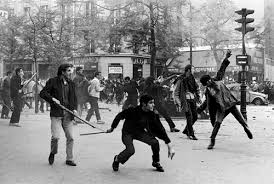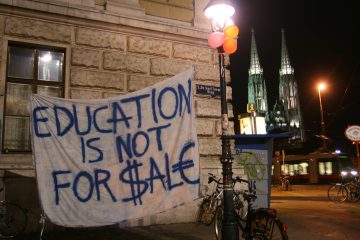On Tuesday, March 16, eight people, including six women of East Asian descent, were shot and killed at three separate spas in the Atlanta, Georgia area. The suspect, Robert Aaron Long, is a white man who had a history of frequenting Asian massage parlors, including the site of his first attack, to obtain sexual services. Although Georgia law enforcement and the FBI are reluctant to label this atrocity as a hate crime, these attacks highlight how racism, sexism, and all the ills of capitalism have intensified during the COVID-19 pandemic.
Racism against East Asians, Southeast Asians, and Pacific Islanders in the United States was already present, but the March 16 attacks have brought this poison violently to the forefront. In the aftermath of this latest individual terrorist attack, Stop AAPI Hate reported that there had been 3,800 anti-Asian racist incidents recorded in the last year since the beginning of the shutdown. This is significantly higher than the 2,600 hate incidents reported the previous year, and 68% of incidents were against women. And Asian residents in the San Francisco Bay Area, New York, and across the nation were already concerned for their safety prior to the events last week.
The rise in anti-Asian racism is a global phenomenon. In May, UN Secretary-General Antonio Guterres stated that “the pandemic continues to unleash a tsunami of hate and xenophobia, scapegoating, and scare-mongering” and urged governments to “act now to strengthen the immunity of our societies against the virus of hate.” In the last year, anti-Asian discrimination has increased in Canada, Italy, Russia, Brazil, New Zealand, and Australia. Police in Great Britain reported a 300% increase in hate crimes against Chinese, East Asian, and Southeast Asians in the first quarter of 2020, compared to the same period in 2018 and 2019.
In the United States, some responsibility has to be laid on Donald Trump, who spewed xenophobic vitriol about the “kung flu” and the “China virus.” According to the journal Health Education & Behavior, anti-Asian discrimination had been on the decline for over a decade but experienced a significant uptick due to discriminatory coronavirus speech. After Mike Pompeo’s March 8, 2020 appearance on “Fox and Friends,” during which he referred to the “China virus,” use of the term skyrocketed 650% on Twitter. But the sickness of anti-Asian racism did not start with Trump. In fact, the United States has a sordid history of such bigotry dating long before March 2020.
History of discrimination
For example, Chinese workers have faced immense discrimination since they started immigrating to the US in large numbers during the 19th century. They took on some of the most dangerous jobs in the construction of the Transcontinental Railroad, which was a massive achievement for American capitalism. This feat of infrastructural expansion reduced coast-to-coast travel time from a matter of months to under a week. The extension of a domestic market from the Atlantic coast to the Pacific Ocean would have been unimaginable without the railroad.
Nonetheless, although Chinese workers made up an insignificant percentage of the population, they were used as a scapegoat and blamed for the depressed wages of white workers. This led to the Chinese Exclusion Act of 1882. It was the first law of its kind in US history, prohibiting Chinese laborers’ entrance into the country for ten years. The Exclusion Act laid the basis for laws and statutes of the same type against workers from the Middle East, South Asia, Japan, and Latin America. Chinese Exclusion officially ended in 1943 but was replaced by the no less racist and reactionary Magnuson Act—introduced by Democrat Warren G. Magnuson—which limited Chinese immigrants to a 105-person annual quota and still denied Chinese immigrants property ownership rights.
And while the US capitalist state eventually became more lenient with Chinese Americans, they turned against Japanese Americans during World War II. By isolating and condemning 120,000 Japanese American citizens and immigrants to internment camps, the capitalists fueled wartime nationalism to claim Japan’s empire for their own. The federal government only redressed the Japanese American people who had been interned in the 1980s, four decades after the war.
The anti-Asian racism that has grown in the past year is thus only a continuation of decades of division and discrimination, built into the foundations of American capitalism. This has numerous implications for the present day.
Discrimination against Americans of Asian descent weighs heavily on their mental health. In 2018, psychologists found that among foreign-born Chinese, Korean, and Vietnamese Americans, over one-quarter of their sample population experienced depressive symptoms—19% higher than the general population. One-fifth to one-third of each sample population was considered depressed, and more females than males were found to be depressed. Moreover, the association between perceived discrimination and depressive symptoms was statistically significant.
Asian store owners and the elderly are especially affected by this discrimination. Among other attacks against elderly Asian Americans and shop owners, a 75-year-old man from Hong Kong in Oakland, CA was robbed and beaten to death on March 11. The suspect, Teaunte Bailey, had a history of victimizing elderly Asian people, but authorities have yet to charge him with a hate crime. This comes at the same time that Asian-owned businesses face economic pressure because of the pandemic. Chinatowns across America are being gentrified, and between February and April of last year, 233,000 Asian-owned small businesses permanently closed. In NYC alone, Chinatown has reported a 60–80% decrease in business. Like much of the petty bourgeoisie, Asian small business owners are being squeezed by the economic crisis.
Asian women, in particular, are subject to discrimination and violence under capitalism because of how they have been portrayed as submissive, hypersexualized, and docile. The history of Asian women’s hypersexualization runs deep. The Page Act of 1875, for instance, ostensibly prevented the immigration of prostitutes to the United States. But in fact, it prevented all Chinese women from entering the country. Likewise, Asian spas like the ones targeted on March 16 are commonly thought to be synonymous with sexual services, although certainly not every Asian spa is a front for this kind of activity.
These stereotypes persist today, and the latest attacks cannot be understood without reckoning with them. Resorting to prostitution is typically predicated on economic precarity, and Asian women face severe discrimination when it comes to job opportunities. In December, the National Women’s Law Center found that for unemployed Asian women 16-years-old and older, a startling 44% had remained unemployed for more than six months, the highest percentage among women generally.
Despite the myth that Asians are the “model minority”—who all supposedly become doctors, lawyers, and engineers—the fact of the matter is that most Asian Americans face significant economic hardship. As of 2018, Asian-Americans are the most economically divided racial or ethnic group in the United States. This reflects the growing income inequality between the capitalist class and the working class more broadly in American society.
Moreover, although Asian-American households enjoy the highest median income, some Asian ethnicities have poverty rates well over the national average of 15.1%, such as Burmese (35%), Bhutanese (33%), Hmong, and Malaysians (28%). These immigrants are often low-skilled workers, compared to high-skilled H-1B1 visa applicants. Their access to high-paying jobs is limited, and the capitalists force different sections of the working class to compete for lower and lower wages.
Divide and rule
Racism in all its forms is, at root, a ruling class tool to divide and rule the working class. Regardless of ethnicity or nationality, all workers must sell their labor power to a capitalist for a wage if they are to sustain themselves and their families. By sowing the poison of hate between workers based on their outward appearance, whether in 1882 or 2020, the capitalists can depress all workers’ wages and control the labor pool with racist border controls. Sexism likewise helps perpetuate a gender wage gap, leading ultimately to lower wages for all workers.
Asian Americans report feeling unheard because, despite repeated attacks against them, the state has not treated anti-Asian hate as a genuine threat to their safety. When addressing the March 16 attacks, a sheriff’s deputy discussed the assailant’s so-called sex addiction and portrayed the killings as the result of “a really bad day” for the suspect. Both the Atlanta police department and the FBI refuse to describe the attacks as a hate crime, arguing that there is no clear racial motivation.
Most incidents of anti-Asian violence are not charged as hate crimes. Georgia’s hate crime statute, passed last year, mandates prosecutors to prove beyond a reasonable doubt that a perpetrator intentionally selected victims based on their appearance. Even if the suspect cannot be shown to have a clear bias against Asians, his claims to so-called sexual addiction should constitute grounds for a hate crime on the basis of sex and gender. However, hate crimes based on sexism are less likely to lead to charges. This is the reality of “protecting and serving the people” under bourgeois law. From New York to Chicago, police departments are increasing patrols after the Georgia spa killings. But the capitalist state and capitalist law are designed to perpetuate
Socialist Revolution – US Section of IMT




0 Comments